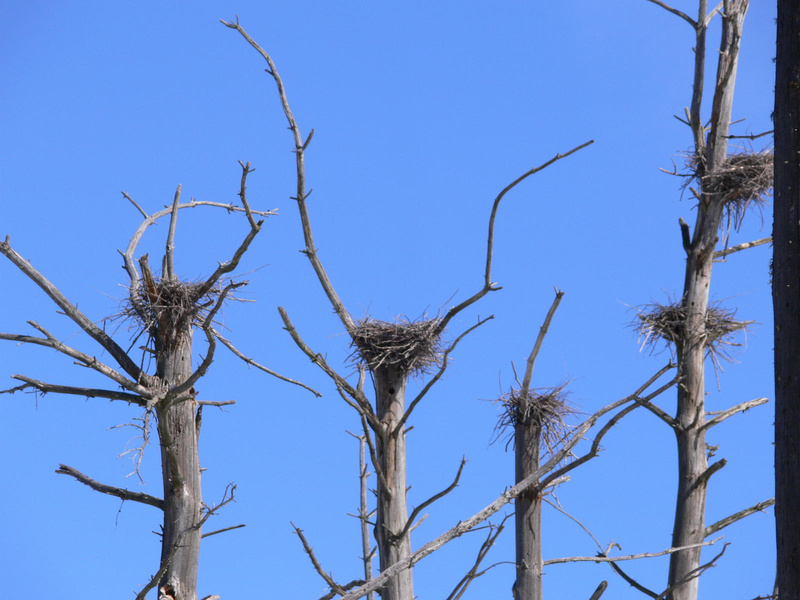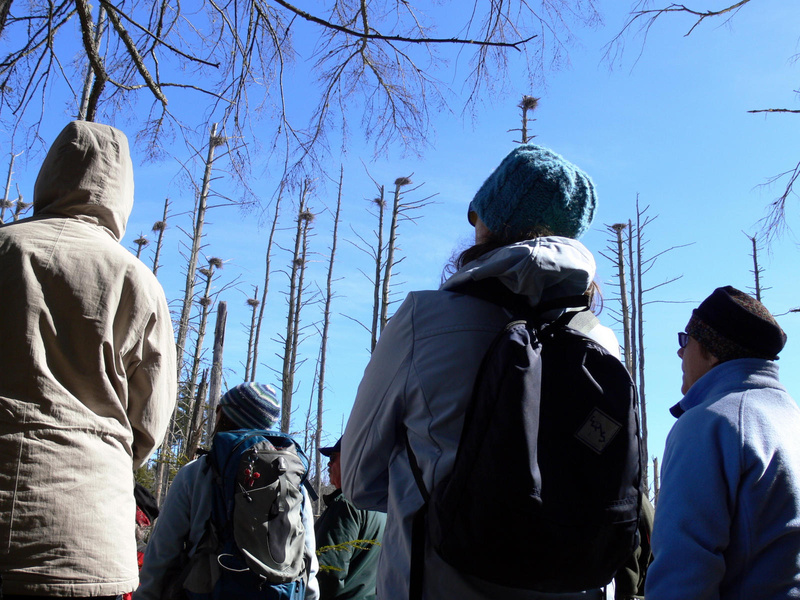You’ve probably seen them standing like a silent sentinel in a pond or secluded cove, patiently waiting, motionless, before striking for a hard-earned meal. Or perhaps you’ve seen one gliding through the air like a wild flying fortress, with long legs trailing behind.
For those who live in the Lake Region, the great blue heron is a symbol of an adept hunter whose presence can turn a common stretch of water into a serene alcove.
It seems the blue heron (Ardea herodias) appreciates the work of a busy beaver. Thanks to their efforts in damming a Bridgton wetland, beavers have created the ideal conditions for a large blue heron rookery, a place where many breeding herons will soon arrive, nest, and raise their young.
Last week, Lakes Environmental Association of Bridgton led a group of 15 to this hidden wonder. In 2004, during “big night,” the annual spring migration of frogs and other woodland amphibians, LEA conservation and education director Bridie McGreavy stumbled upon this grove of dead pines with nests at the top.
“I heard all this squawking and pterodactyl-type noise,” McGreavy said. “I came back in the daytime and thought this place was pretty amazing.”
Indeed, it is. Though it’s a bit early in the season for the birds to be found here a short walk along the cross-country ski trails behind the Bridgton Highlands golf course will lead you to a grove of standing dead trees and some 30-odd blue heron nests. It’s a perfect spot for the blue heron — the largest and most numerous “colonial wading bird” in Maine. They’re safe from four-legged predators and close to fishing spots in the nearby Highland and Long Lake watersheds.
Colonial wading birds are named such simply because they nest together in colonies for protection. “In the summer months, I’ve found there’s usually a scout in one of the large pine trees,” said McGreavy. “He will flush and warn the others. I would not lead a group in here when they’re nesting.”
The pine trees died after the beavers dammed and flooded the low-lying area decades ago. No one is sure how long the rookery has been here, but because herons are a relatively long-lived bird, they are a good indicator of environmental quality. Wetland health, levels of toxic substances, and human disturbance factors can be gauged through their continued presence.
Toward that end, last year Maine Inland Fisheries and Wildlife biologist Danielle D’Auria started the Heron Observation Network, a volunteer group trying to get a handle on the health of the heron population in the state.
“Because we’re short staffed and under budget constraints, the volunteers provide a valuable service,” said D’Auria. “We discovered there were 83 active colonies last year. Every five to 10 years the state does a fly-over with aircraft.”
One of some 78 volunteers with the Heron Observation Network, Joe Moger of Westbrook was along for Friday’s walk and has adopted three heron colonies. As an observer, he must visit his sites at least once a year during the breeding season (May-August) to document whether or not the rookery is being used. Moger is enjoying the opportunity. “It turns out to be a passion,” he said, holding a pair of binoculars.
According to Department of Inland Fisheries and Wildlife research, heron colonies in Maine may be declining. Sometimes rookeries are abandoned. Much like the positive relationship between beavers and herons, Mother Nature is a web of interdependent players, but does not always yield a favorable relationship; one success story can come at the expense of another.
Take the bald eagle. The increased number of Maine’s eagles now prey upon coastal herons. From 1983, Maine’s coastal breeding population of great blue herons has been declining from 1,028 pairs down to 430 in 2009. MDIFW actually listed the great blue heron as a Species of Special Concern in 2007. Though not as serious as Endangered or Threatened, Species of Special Concern is used for planning and informational purposes.
Because of the number of nests, the Bridgton rookery is significant, listed in the second largest category on MDIFW state rookery maps. It’s likely the largest inland rookery in Cumberland County, which currently has about 10 active rookeries. The largest rookeries in our area are typically found along the coast.
For more on the Heron Observation Network, visit maineheron.wordpress.com.
Don Perkins is a freelance writer who lives in Raymond. He can be reached at: presswriter@gmail.com
Send questions/comments to the editors.



